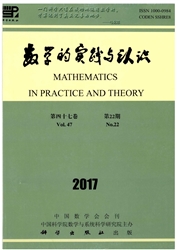

 中文摘要:
中文摘要:
客运量受诸多因素影响因此数据波动性大,并且具有小样本性及贫信息等特点.采用基于最小二乘法改进的GM(1,1)模型,对上海市的客运量进行短期预测.首先介绍了普通GM(1,1)模型的建立方法;然后通过最小二乘法的原理弱化波动较大的数据,减少随机性,加强规律性建立改进的新GM(1,1)模型;其次结合2005—2014年数据建立预测模型;最后使用2014年数据对模型可靠性进行验证.结果表明该预测方法精度高误差小,改进的模型预测结果更加接近实际值.该模型为其他相关预测提供了理论依据,也便于上海市对未来交通运输的宏观调控.
 英文摘要:
英文摘要:
Passenger traffic is affected by many factors, so the data volatility is large, and has a small sample and poor information and so on. In this paper, the GM (1,1) model based on the least square method is used to forecast the passenger volume of Shanghai. First, we introduce the method of GM (1,1) model, and then weaken the data with large fluctuation by the principle of least squares, reduce the randomness, strengthen the regularity and establish the new GM (1,1) model; Combined with the data from 2005 to 2014 to establish the forecast model; Finally, the 2014 data used to verify the reliability of the model. The results show that the precision of the method is high and the error of the improved model is much closer to the actual value. The model provides a theoretical basis for other related forecasting, and also facilitates the macro-control of the future transportation in Shanghai.
 同期刊论文项目
同期刊论文项目
 同项目期刊论文
同项目期刊论文
 期刊信息
期刊信息
